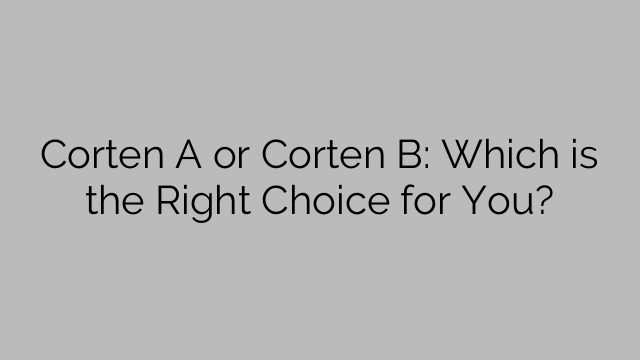Corten A and Corten B are two distinct grades of weathering steel that have gained popularity in architectural and industrial applications. Known for its unique rusty appearance and exceptional durability, Corten steel has become a preferred choice for many designers and engineers. However, when it comes to selecting the appropriate grade of Corten steel, the decision between Corten A and Corten B can be a challenging one. In this article, we will discuss the characteristics and differences between these two grades to help you make an informed choice.
Firstly, let’s understand what Corten steel is. Corten steel, also known as weathering steel, is a low-alloy steel that forms a protective oxide coating when exposed to the elements. This coating acts as a barrier, providing resistance against corrosion and atmospheric deterioration. Over time, Corten steel develops a unique patina that adds character to any structure and eliminates the need for periodic painting or maintenance.
Corten A is the original weathering steel and is widely recognized for its corrosive resistance and structural strength. It contains high amounts of copper, chromium, and phosphorus, which enhance its resistance to atmospheric corrosion. Corten A is primarily used in architectural applications such as building facades, bridges, and sculptures. Its distinct reddish-brown color and ability to withstand harsh weather conditions make it a popular choice in outdoor installations.
On the other hand, Corten B is a newer grade of weathering steel that was specifically developed for more demanding environments. It contains a higher percentage of phosphorus and is often used in industrial applications such as railway wagons, containers, and tanks. Corten B offers improved resistance to corrosion, making it suitable for environments with higher levels of pollutants or corrosive agents. Despite its enhanced durability, Corten B still maintains the attractive patina and aesthetic appeal associated with Corten steel.
When deciding between Corten A and Corten B, it is important to consider your specific application and environmental conditions. Corten A is a versatile option that performs well in most outdoor environments. Its weldability and formability make it a suitable choice for various projects. However, if your structure will be exposed to particularly challenging conditions, such as near coastal areas or heavy industrial settings, Corten B may provide additional protection against corrosion.
In terms of availability and cost, Corten A is more readily available and generally less expensive compared to Corten B. This makes it a preferred choice for many projects, particularly those with budget constraints. However, it is worth noting that Corten B may provide longer-lasting protection in certain applications, potentially offsetting the higher initial cost.
In conclusion, both Corten A and Corten B offer excellent corrosion resistance and aesthetic appeal. The choice between the two ultimately depends on the specific requirements of your project. Whether you are designing an eye-catching architectural facade or constructing a robust industrial structure, consulting with a professional engineer or architect can help you determine the most suitable grade of Corten steel for your needs. Regardless of the grade chosen, Corten steel is a unique and durable material that will lend character and longevity to any project.
[ad_2]

